Abstract
Sweet potatoes have multiple uses as food, feed, and in industrial production. They are characterized by their need for high temperatures for optimal development. This study aimed to analyze the quantitative and qualitative aspects of growing sweet potato cultivars in southwest Romania using mulching and non-mulching systems. The effects of mulching on the production of tuberous roots and the contents of total soluble substance, vitamin C, starch, total polyphenols, and antioxidant activity (DPPH) were evaluated in three cultivars with white pulp (the ‘Pumpkin’ and ‘Chestnut’ cultivars) and with orange pulp (the ‘Italian’ cultivar). It was found that mulching with polyethylene film improved the production of sweet potatoes, amounting to 41.42 t/ha in the case of the ‘Italian’ cultivar. Moreover, the effect of mulch induced increases in total soluble substance (16.40%) and starch (16.01%) in the ‘Chestnut’ cultivar, in vitamin C (9.23 mg/100 g d.w.) in the ‘Pumpkin’ cultivar, and in antioxidant activity in the ‘Pumpkin’ (2716.55 µmol AsA/g d.w.) and ‘Chestnut’ cultivars (1131.31 µmol AsA/g d.w.), while the polyphenols in the ‘Italian’ cultivar decreased.
1. Introduction
Sweet potato (Ipomea batatas L.) is a very important crop and is used as a type of food, as fodder, and as an industrial and ornamental plant. The production of sweet potatoes in Europe represents the lowest proportion globally (0.1%), with European production amounting to only 56,113 tons in 2014 [1]. The main producers of sweet potatoes in Europe are Spain, Portugal, Italy, and Greece [2].
The tuberous root is mainly used for human consumption, in animal nutrition, but is also used in industry for the production of starch, alcohol, flour, and natural dyes (obtained from orange and purple varieties). The leaves with the petiole or young shoots from this crop are also consumed due to their unique nutritional properties [3,4]. The sweet potato tubers are characterized as having anti-diabetic, anti-oxidizing, and anti-proliferative properties due to the presence of valuable nutritional and mineral components [5]. The main nutrients in sweet potato tubers are carbohydrates, proteins, fats, and vitamins soluble in fat [6]. The quality of sweet potato preparations depends on the sugar contents, the texture of the tubers, and the quality of the carbohydrates [7].
Plastic film mulching is used as a water saving measure in many crops. Plastic film mulching in a low precipitation season with high temperatures in a garlic culture setup after a rice culture led to an improvement in garlic quality but reduced the contents of vitamin C and flavonoids [8]. In fruit growing, the use of mulch increased soluble solid contents in plum trees [9].
The polyethylene mulch increases the soil temperature and humidity, especially at the beginning of spring, thus favoring crop establishment. This synthetic mulch reduces weeds and certain pests (insects) and also stimulates higher production by improving the efficient use of soil nutrients [10].
Mulching with polyethylene film can significantly improve the accumulation rate of dry substances in sweet potato roots [11].
Recent studies conducted in China showed that mulching with polyethylene film may have a negative effect on the yield of sweet potato production because it increases soil moisture and decreases porosity compared to conventional variants, in which water is drained, evapotranspiration takes place, and water is not stored [12,13].
However, the question of whether mulching can be used to improve the quality of sweet potato production remains unclear. The main objective of this study was to evaluate the influence of two culture systems (non-mulching and mulching) on the yields and quality parameters of tuberous roots.
2. Materials and Methods
2.1. Plant Material and Growing Conditions
The experiment took place during the 2017–2018 period in the Banu Mărăcine Didactic Station (44°19′ N and 23°51′ E)—a sector of the Faculty of Horticulture, belonging to the University of Craiova.
The experiment had a 3 × 2 factorial block design and was set up annually during study period. The A factor accounted for three grades: a1—‘Pumpkin’; a2—‘Italian’; a3—‘Chestnut’; and the B factor was the technological stage with two grades: b1—without mulch; and b2—with mulch. The ‘Pumpkin’ and ‘Chestnut’ cultivars used in this study originate from South Korea, and the ‘Italian’ cultivar from Italy. The planting of sweet potato cuttings was carried out in the first year on 5 May 2017 and, in the second year, on 4 May 2018, when the average temperature was above 15 °C (Table 1). The trial was established on a reddish brown preluvosoil with the following chemical properties: 26.6 mg.kg−1 total N, 789 mg.kg−1 total P, 331 mg.kg−1 total K, 2.67% humus, and pH 7.06. Main fertilization was applied once at experimental setup, using grape pomace compost equal to 30 t.ha−1.

Table 1.
The climatic conditions during the vegetation period of the sweet potato [14].
Planting was performed on raised beds of 70 cm, and each cultivar was planted in two variants (double rows): non-mulching and with mulching using black high-density polyethylene film (0.02 mm, 1.2 m wide). All variants had 3 replicates. These were set up linearly in each row, in the same order due to the small size of the trial and the uniformity of the soil, with 10 plants per repetition. The distance between the rows was 1.20 m, and the distance between the plants in each row was 0.30 m. The weeds were removed several times, manually, in the mulch-free variant, but no intervention was applied thereafter to the mulched variant. Drip irrigation was provided during the vegetation period every 7–10 days (200–250 m3.ha−1). No additional pest control was applied throughout the vegetation period for any variant. Harvest was performed on 5 October 2017 in the first year and on 8 October 2018 in the second.
The quantitative parameters of the sweet potato are as follows:
The tuberous roots of sweet potatoes were sorted according to their average weight and observed preferences of domestic buyers, resulting in two classes:
- >150 g—tradable tuberous roots;
- <150 g—non-tradable tuberous roots.
The average weight of tubers (g), the average yield per plant (g), and the total yield per hectare (t/ha) were determined in the experiment. The latter was established on the basis of the average yield per plant and the total number of plants per hectare (27,000 plants/ha).
2.2. Analytical Methods
2.2.1. Material
Gallic acid hydrate (99%), Panreac (Barcelona, Spain).
Folin-Ciocalteu’s phenol reagent, Sigma-Aldrich (St. Louis, MO, USA).
Formic acid, Carlo erba (Rodano, Italy).
Sodium carbonate anhydrous (99%), Penta (Praha, Czechia).
2,2-diphenyl-1-picrylhydrazyl (DPPH), Sigma-Aldrich (St. Louis, MO, USA).
Methanol, Sigma-Aldrich (Steinheim, Germany).
2.2.2. Methods
Total soluble substance. The total soluble substance (TSS) content was determined with a refractometer DR 301-95 (A. Krüss Optronic, Hamburg, Germany) at 20 °C and results were expressed in °Brix.
The vitamin C was determined using the iodometric method, and reducing sugars (%) with the colorimetric method using 3.5 dinitrosalicylic acid (DNS).
Starch was determined from the potatoes as described in [15].
Screening batch stirred-tank extractions. A total of 2.5 g of dried powdered plant material was transferred into a 50 mL conical-bottomed flask with 50 mL of solvent methanol: H2O (60:40), to give a liquid-to-solid ratio (RL/S) of 20 mL g−1. The mixture was extracted at room temperature for 4 h, under continuous stirring at 300 rpm, on a thermostated hot plate (Witeg, Wertheim, Germany). An aliquot of 1 mL of the obtained extract was placed in a 1.5 mL Eppendorf tube and centrifuged at 10,000× g for 10 min. The clear supernatant was used for all analyses.
Total polyphenol content determination. All samples were diluted appropriately with 0.5% aqueous formic acid prior to determinations. An aliquot of 0.1 mL of diluted sample was mixed with 0.1 mL Folin-Ciocalteu reagent in a 1.5-mL Eppendorf tube and allowed to stand for 2 min. Following this, 0.8 mL of Na2CO3 solution (5% w/v) was added to the mixture and the tube was incubated in a thermostated water bath at 40 °C, for 20 min. After incubation, the tube was cooled with tap water and the absorbance was recorded at 740 nm, using an appropriate blank. Determination of total polyphenol concentration (CTP) was carried out using a gallic acid calibration curve (10–80 mg L−1) and results were expressed as mg gallic acid equivalents (GAE) L−1. The extraction yield in total polyphenols was then calculated as follows:
where V is the extraction volume (in L) and dm is the dry mass of the solid material (in g) [16,17].
Determination of the antiradical activity (AAR). A total of 0.025 mL of each extract was mixed with 0.975 mL DPPH (100 μM in methanol) and incubated at ambient temperature. The absorbance at 515 nm was read at t = 0 min (immediately after mixing) and at t = 30 min. The AAR of the extract was determined using the following equation:
where CDPPH and CTP are the DPPH concentration (μM) and total polyphenol concentration (mg · L−1) in the reaction mixture, respectively, A515(f) is the A515 at t = 30 min, and A515(i) is the A515 at t = 0. AAR was given as μmol DPPH g−1 dry mass [18,19].
2.3. Statistical Analysis
The data obtained were analyzed using ANOVA: two-factor with replications in Microsoft Excel 2019. Multiple comparison was performed using Tukey’s multiple range test, with the help of DSAASTAT ver. 1.514 Excel VBA Macro [20].
3. Results
The production and quality elements of the tuberous roots recorded in sweet potatoes were significantly influenced by the cultivation system and the cultivar under study. Regarding the average weight of the tuberous roots of sweet potatoes, there were differences between the three cultivars in both the non-mulching and mulching variants. The statistical analysis showed significant differences between the ‘Chestnut’ and ‘Pumpkin’ cultivars, for both culture systems (Figure 1 and Figure 2).
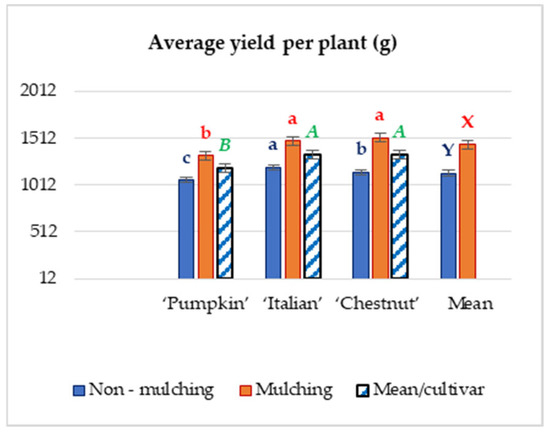
Figure 1.
Effect of the cultivar on the production parameters of marketable sweet potato tubers; average yield per plant (g). Bars represent standard error. Means followed by same letter are not significantly different (Tukey’s multiple range test, p < 0.05).
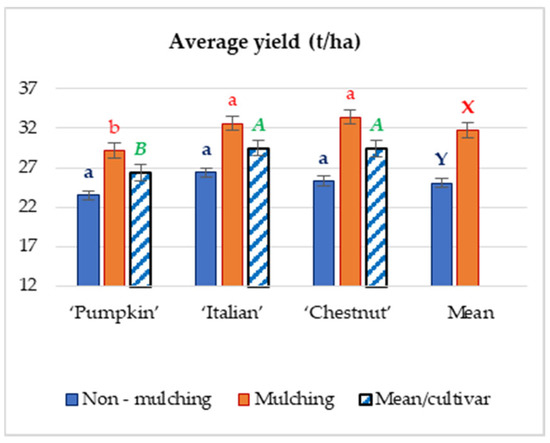
Figure 2.
Effect of the cultivar on the production parameters of marketable sweet potato tubers; average yield (t/ha). Bars represent standard error. Means followed by same letter are not significantly different (Tukey’s multiple range test, p < 0.05).
Regarding the aspect of trading (tubers over 150 g), the average yield per plant in the mulched variants varied from 1067.64 g for the ‘Pumpkin’ cultivar to 1199.52 g for the ‘Italian’ cultivar (Table 2), with statistically significant differences between cultivars (Figure 1). The highest yield of tuberous root in the mulched varieties was recorded in the ‘Chestnut’ cultivar with 348.7 g. The average yield per hectare, recorded in tradable tubers, was influenced by cultivar: it was higher for the ‘Italian’ cultivar (26.38 t/ha) and lower for the ‘Pumpkin’ cultivar (23.48 t/ha), in the non-mulched variants (Table 2). The statistical analysis showed significant differences between the mulched and non-mulched variants (Figure 2).

Table 2.
The effect of cultivar on the production parameters of the sweet potato.
By comparing the results of the current study with previous ones, we can say that yield is determined by cultivar and climatic conditions in the years of culture. In a mulch culture, the aerial part of the plants develops very well, the leaf surface increases, and, in this way, the assimilation surface increases. All this determines a better deposition of the synthesized substances in the tuberous roots, thus increasing the production of tubers. The total yield, in tradable tubers, in the case of the mulched variants oscillated from 33.39 t/ha for the ‘Chestnut’ cultivar to 29.15 t/ha in the ‘Pumpkin’ cultivar (Figure 2).
It was observed that mulching favorably interacted with the ‘Chestnut’ cultivar, which recorded a yield increase of almost 8.0 t/ha, superior to that obtained in the non-mulched variant. Both mulch and cultivar significantly influenced the total yield, in which the tuberous roots below 150 g/piece (Table 2) were included.
The average total yield of tradable and non-tradable tubers for sweet potatoes (t/ha), when dependent on the cultivar, was higher for the ‘Italian’ cultivar (35.04 t/ha), and when dependent on the cultivation system, was higher for the three mulched cultivars (40.05 t/ha) (Figure 2).
Under the mulch foil, the tuberous roots exhibited increased lengths and reduced diameters and thus broke very quickly at harvest, becoming unmarketable. The ‘Pumpkin’ cultivar was prone to this inconvenience, which will require more studies over a number of years to rectify by adjusting the culture system and environmental conditions.
However, these yield differences between the mulched and non-mulched variants can also be influenced by rainfall during the growing season or the adaptation of cultivars to the environment, which can play a very important role in the obtained yields.
The total soluble substance (TSS) content, in the non-mulching variant, oscillated from 13.6% for the ‘Italian’ cultivar to 14.7% in the ‘Chestnut’ cultivar. The ‘Pumpkin’ cultivar also had a high content (14.1%) of TSS (Figure 3). Under mulching, the total soluble substance content for the same cultivar was higher. It should be noted that while the ‘Italian’ cultivar recorded the lowest value in the mulched version, it had 14.4% TSS.
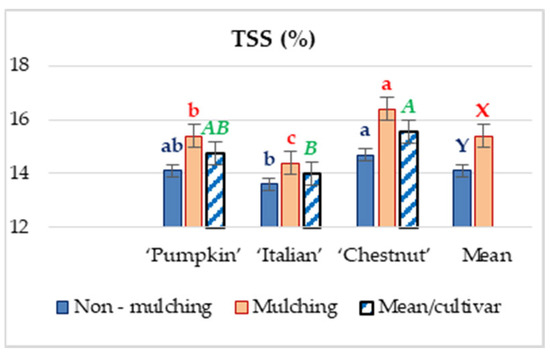
Figure 3.
Total soluble substance of tuberous sweet potato roots (%). Bars represent standard error. Means followed by same letter are not significantly different (Tukey’s multiple range test, p < 0.05).
The starch content varied between 13.7–14.6% in the non-mulched variants and between 14.3–16.0% in the mulched versions (Figure 4). It was observed that the variation of this content depended on the cultivar, but the mulch also positively influenced the accumulation of starch.
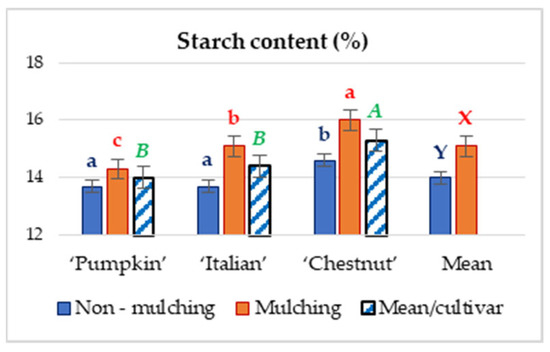
Figure 4.
Starch content of tuberous sweet potato roots (%). Bars represent standard error. Means followed by same letter are not significantly different (Tukey’s multiple range test, p < 0.05).
The antioxidant activity due to vitamin C content, total polyphenols, and antioxidant activity (DDPH) are shown in Figure 5, Figure 6 and Figure 7.
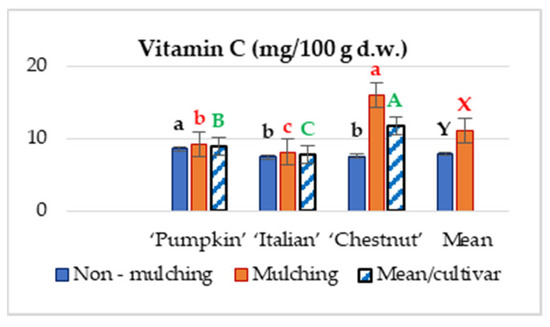
Figure 5.
Vitamin C in tuberous sweet potato roots (mg/100 g d.w.) Bars represent standard error. Means followed by same letter are not significantly different (Tukey’s multiple range test, p < 0.05).
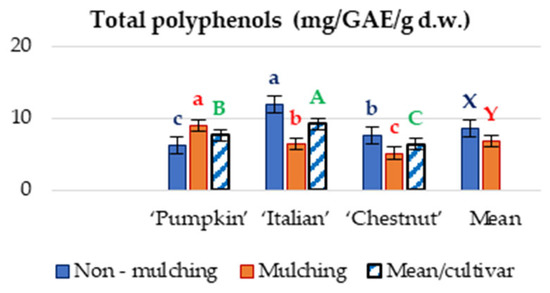
Figure 6.
Total polyphenols in tuberous sweet potato roots (mg/GAE/g d.w.). Bars represent standard error. Means followed by same letter are not significantly different (Tukey’s multiple range test, p < 0.05).
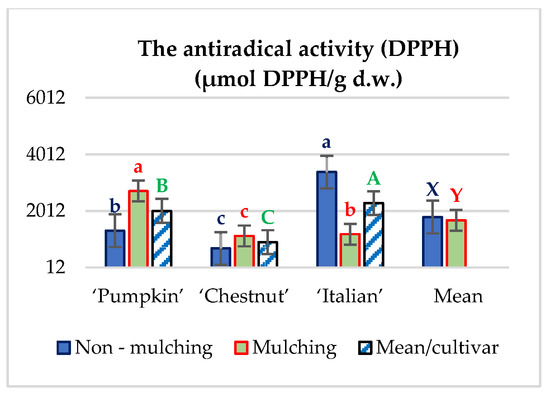
Figure 7.
The antiradical activity (DPPH) of tuberous sweet potato roots (µmol DPPH/g d.w.). Bars represent standard error. Means followed by same letter are not significantly different (Tukey’s multiple range test, p < 0.05).
The analysis of the variance of the obtained results (Tukey’s multiple comparison test, p < 0.05) showed statistically significant differences in vitamin C content between the tested cultivars (Figure 5). The average vitamin C content increased in the following cultivar order: ‘Italian’ (7.46 mg/g d.w.), ‘Chestnut’ (7.58 mg/g d.w.), and ‘Pumpkin’ (8.62 mg/g d.w.) for the non-mulching variants. The values ranged between 8.16% in the ‘Italian’ cultivar to 16.0% in the ‘Chestnut’ cultivar in the mulched variants.
The total polyphenols content recorded in the present study, in the mulched variant, was between 5.12 mg GAE/g d.w. in the ‘Chestnut’ cultivar and 9.01 mg GAE/g d.w. in the ‘Pumpkin’ cultivar, while for the non-mulched variant, it ranged from 6.23 mg GAE/100 g d.w. in the ‘Pumpkin’ cultivar to 11.94 mg GAE/100 g d.w. in the ‘Italian’ cultivar (Figure 6). It is observed that this constituent was not influenced by the presence of mulch, where the average was 6.83 mg GAE/g d.w. total polyphenols; whereas it was 8.58 mg GAE/g d.w. in the non-mulched variant.
The antiradical activity (DPPH) of the three sweet potato cultivars tested in this study is presented in Figure 7. The statistical analysis indicates that, in the mulch-free variants, the ‘Italian’ cultivar recorded the highest antioxidant activity (3390.26 µmol DPPH/g d.w.) and the ‘Chestnut’ cultivar recorded the lowest (only 686.66 µmol DPPH/g d.w.). The highest value in the mulched variants was registered in the ‘Pumpkin’ cultivar. Significant differences were observed between the three cultivars, demonstrating the importance of the cultivar and the applied technological sequence.
These results demonstrate that the cropping system can positively influence the antioxidant activity of some sweet potato cultivars.
4. Discussion
The sweet potato is a crop with good adaptability to soil and climate conditions and requires maximum daily air temperatures between 30.0 °C and 35.3 °C for growth and development.
The average weight of sweet potato tuberous roots is variable and depends on the cultivar. These results are similar to those reported in a study in Slovenia [1], where the average weight of the tuberous roots varied from 332.73 to 428.15 g, which is lower than those with a variation in average weight of 210 to 400 g [21] or with an average weight from 308.93 to 647.75 g, as reported in Martinique [22]. The use of mulch positively influenced the development of tuberous roots (351.76 g in mulched and 232.24 g in unmulched soil) [1].
The results obtained for the mulched variants are consistent with those that reported a total yield variation from 20.8 to 25.5 t/ha, according to cultivar and culture year [23]. Similar results were also reported in a study of 14 sweet potato cultivars tested in the U.S. [24]. At the University of Nitra, Slovakia, crop yields between 32.01 and 39.30 t/ha were obtained [1], superior to those reported by us. An average crop yield of 36.7 t/ha was reported in [25]. The results of the present study are superior to those reported in sub-Saharan Africa using a fertilized culture with poultry manure and NPK, in which the average yield was 12.4 t/ha [26]. Generally, the yield in sweet potatoes varies from 20 to 25 t/ha for promising varieties, grown with improved production sequences, similar to mulching [27]. A study conducted in 2015 and using ‘Pumpkin’ and ‘Chestnut’ cultivars reported yields of 35.6 t/ha in the ‘Chestnut’ cultivar and 53.3 t/ha in the ‘Pumpkin’ cultivar [22].
Our results are consistent with those previously reported [25,28] wherein black mulch in the sweet potato crop influenced the total yield of tradable roots [29]. A 32.56% yield increase was recorded for a sweet potato-mulched crop grown in Central China, as compared to one without mulch [29]. Black plastic mulch used in combination with drip irrigation produced an increase in total tradable yield compared to sweet potato grown on non-mulched land [30]. Black film and mulching on the top (ridge) of the raised rows were more favorable for crop growth and yields in arid areas of China [30].
Sweet potato is consumed in countries with warm climates, mainly by low-income people, and is one of the cheap substitutes for staple foods such as rice, wheat, and potatoes [31] because it contains a considerable level of starch, soluble sugars, vitamins, minerals, and other nutrients. TSS accumulation was influenced by the sweet potato cultivar, not by the culture system used (polyethylene mulch of different colors) [28]. In contrast, in a mulched garlic crop, the TSS content depended on the culture system [8].
The high starch content is very important, both for fresh consumption and for the flour, which can be obtained from tuberous roots. All three sweet potato cultivars grown in the southwestern part of Romania accumulated a large amount of starch, and can be compared with varieties grown in Sri Lanka, an area favorable to this species [32].
Previous studies showed that there is a positive correlation between the starch content and the total dry matter content. However, these parameters can vary greatly depending on the cultivar, harvest season, growing area, and climatic conditions [32].
In a study conducted to observe the influence of cultivar on the vitamin C content, the results varied between 155 and 322 mg/kg f.w. [33]. These values are higher than those obtained in the current study. The effect of the variety on the vitamin C content of sweet potatoes was observed and it was found that varieties with orange pulp have a higher content (252–386 mg/kg f.w.) compared to those with cream or yellow pulp (237–381 mg/kg) [34]. The vitamin C content in the ‘Beauregard’ variety was only 64 mg/kg f.w. [35], which is lower than the values recorded in the present study. Vitamin C values of 6.15 and 4.28 mg/100 g f.w. were reported in [36] and values of 27.7 mg/100 g f.w. were reported in [37].
Our results regarding total polyphenols indicated superior values to those previously reported, which oscillated between 0.57–0.79 mg/g f.w. [38] or from 0.03 to 0.95 mg/g f.w. [39]. The content of total polyphenols in a sweet potato cultivar, ‘OFSP’, grown in Thailand was 1.94 mg GAE/g f.w. [40]. In the same study, the total polyphenol content of the ‘OFSP’ cultivar grown in Bangladesh ranged from 0.95 to 1.37 mg GAE/g f.w.
In recent years, increasing attention has been devoted to natural phenolic compounds, as a large amount of them can be found in plants and plant products. Therefore, the consumption of products with a high content of such compounds can reduce the risk of developing several diseases due to their antioxidant activity. The content of polyphenols may vary depending on the species, and its level may be influenced by environmental factors, soil type, degree of sun exposure, precipitation, or the degree of maturity of the edible organs. Sweet potatoes grown in areas with long days and lower temperatures accumulated a higher content of total polyphenols [41].
Moreover, the culture system has an influence on the total polyphenol content. Organically grown sweet potatoes contain higher levels of total polyphenols than those grown in the conventional system [42]. The total polyphenols in the sweet potato tubers had values that significantly varied between cultivars and cultivation systems (mulch).
DPPH free radical scavenging activity can be affected by several factors, e.g., culture system, cultivar, drought, time of harvest, and heat processing. Determining the antioxidant capacity of four sweet potato cultivars showed that those with orange pulp have a higher antioxidant capacity than cultivars with cream pulp, but also the stress caused by drought seems to increase their antioxidant capacity [34]. Mulching was found to have a positive impact on the vitamin C content in the ‘Siberian’ sweet potato cultivar compared to the unmulched variant [1].
The results of our study are superior to those reported for sweet potato varieties with purple pulp, which are grown in Japan [42], or sweet potatoes with red pulp [43]. The antioxidant activity of the ‘Ayamurasaki’ cultivar was determined and it was found that the ability to eliminate the free radical DPPH is superior to that of red cabbage, grape skin, sunflower, or red corn extract [44].
Mulching with black polyethylene foil can increase the quantitative and qualitative yield of sweet potato crops; however, this growing technology can be improved and the foil must be recovered to protect the environment.
5. Conclusions
In this study, the efficiency of the sweet potato culture system using black polyethylene film mulch was determined. As a result of this technological approach, the total average production yield for the three cultivars was 40.05 t/ha for the mulched culture compared to 32.97 t/ha for the non-mulched variant. The largest difference between the mulch and mulch-free crop system was observed in the ‘Chestnut’ cultivar (+8.69 t/ha), followed by the ‘Italian’ cultivar (+6.38 t/ha) and the ‘Pumpkin’ cultivar (+6.17 t/ha). In terms of marketable tuber production (<150 g), the increase in mulch cultivation system was +8.08 t/ha in the ‘Chestnut’ cultivar, +6,23 t/ha in the ‘Italian’ cultivar, and +5.67 t/ha in the ‘Pumpkin’ cultivar compared to the non-mulched crop.
The presence of mulch had a positive impact on the content of TSS, starch, and vitamin C. Thus, the average for the three cultivars was 15.4% for TSS (+1.3% more than in the case of the culture without mulch), 15.1% starch (+1.1%), and 11.13 mg/100 g d.w. (+3.25 mg/100 g d.w.). The adaptation of the cultivar to the climate and soil conditions and the influence of the cultivation system (mulch) highlighted the ‘Italian’ cultivar in terms of the total yield (41.42 t/ha) and the ‘Chestnut’ cultivar in terms of the production of marketable tubers (33.39 t/ha), TSS content (16.4%), starch (16.0%), and vitamin C (16.01 mg/100 g d.w.).
In contrast, the presence of mulch had a negative impact on total polyphenol content and antiradical activity. Thus, the average for the three cultivars was 6.23 mg/GAE/100 g d.w. for total polyphenols (−1.75 mg/GAE/100 g d.w. less than in the case of the non-mulched culture) and 1678.55 μmol DPPH/g d.w. (−118.24 μmol DPPH/g d.w.). The antiradical activity was influenced by the presence of mulch in the ‘Pumpkin’ and ‘Chestnut’ cultivars, while in the ‘Italian’ cultivar, it was higher in the non-mulching system. Interaction between the two factors (cultivar x culture system) influenced the tradable and nutritious quality of the tubers.
The results of the present study will be used to develop other technological sequences for the cultivation of sweet potatoes in the southwestern part of Romania. In the future, we will focus on the specific climate and soil conditions, the irrigation system, weed control, and effective mulching parameters.
Author Contributions
Conceptualization, M.D. and M.B.; methodology, M.D., M.B. and S.L.; validation, M.D., R.S. and S.L.; investigation, M.D., R.S., K.P., I.K., E.B., D.P.M., S.L. and M.B.; data curation, M.D., R.S. and S.L.; writing—original draft preparation, M.D., R.S., S.L. and M.B.; writing—review and editing, M.B. All authors have read and agreed to the published version of the manuscript.
Funding
This research received no external funding.
Institutional Review Board Statement
Not applicable.
Informed Consent Statement
Not applicable.
Data Availability Statement
Not applicable.
Conflicts of Interest
The authors declare no conflict of interest.
References
- Šlosár, M.; Mezeyová, I.; Hegedüsová, A.; Golian, M. Sweet potato (Ipomoea batatas L.) growing in conditions of southern Slovak republic. Potravinarstvo 2016, 10, 384–392. [Google Scholar] [CrossRef] [Green Version]
- FAO Stat Database. 2021. Available online: https://www.fao.org/faostat/en/#data/QCL (accessed on 5 November 2021).
- Dinu, M.; Soare, R.; Băbeanu, C.; Hoza, G. Analysis of Nutritional Composition and Antioxidant Activity of Sweet Potato (Ipomoea batatas L.) Leaf and Petiole. J. Appl. Bot. Food Qual. 2018, 91, 120–125. [Google Scholar] [CrossRef]
- Tanaka, M.; Ishiguro, K.; Oki, T.; Okuno, S. Functional components in sweet potato and their genetic improvement. Breed. Sci. 2017, 67, 52–61. [Google Scholar] [CrossRef] [PubMed] [Green Version]
- Dinu, M.; Băbeanu, C.; Hoza, C.; Sima, R.; Soare, R. Nutraceutical value and production of the sweet potato (Ipomoea batatas L.) cultivated in South-West of Romania. J. Cent. Eur. Agric. 2021, 22, 285–294. [Google Scholar] [CrossRef]
- Allen, C.J.; Corbitt, A.D.; Maloney, K.P.; Butt, M.S.; Truong, V.D. Glycemic index of sweet potato as affected by cooking methods. Open Nutr. J. 2012, 6, 1–11. [Google Scholar] [CrossRef]
- Kitahara, K.; Nakamura, Y.; Otani, M.; Hamada, T.; Nakayachi, O.; Takahata, Y. Carbohydrate components in sweet potato storage roots: Their diversities and genetic improvement. Breed. Sci. 2017, 67, 62–72. [Google Scholar] [CrossRef] [Green Version]
- Najafabadi, M.B.M.; Peyvast, G.; Asil, M.H.; Olfati, J.A.; Rabiee, M. Mulching effects on the yield and quality of garlic as second crop in rice fields. Int. J. Plant Prod. 2012, 6, 279–289. [Google Scholar] [CrossRef]
- Kim, E.J.; Choi, D.G.; Jin, S.N. Effect of pre-harvest reflective mulch on growth and fruit quality of plum (Prunus domestica L.). Acta Hortic. 2008, 772, 323–326. [Google Scholar] [CrossRef]
- Kashi, A.; Hosseinzadeh, S.; Babalar, M.; Lessani, H. Effect of black polyethylene mulch and calcium nitrate application on growth, yield of watermelon (Citrullus lanatus). J. Sci. Tech. Agric. Nat. Res. 2004, 7, 235–246. [Google Scholar]
- Jiang, Y.; Shi, C.; Wang, Z.; Wang, C.; Liu, H. Effects of plastic film mulching on arable layer soil temperature, moisture and yield of sweet potato. Chin. J. Eco-Agric. 2014, 22, 627–634. [Google Scholar]
- Hou, F.; Zhang, L.; Xie, B.; Dong, S.; Zhang, H.; Li, A.; Wang, Q. Effect of plastic mulching on the photosynthetic capacity, endogenous hormones and root yield of summer-sown sweet potato (Ipomoea batatas (L). Lam.) in Northern China. Acta Physiol Plant. 2015, 37, 164. [Google Scholar] [CrossRef]
- Vial, L.K.; Lefroy, R.D.B.; Fukai, S. Application of mulch under reduced water input to increase yield and water productivity of sweet corn in a lowland rice system. Field Crops Res. 2015, 171, 120–129. [Google Scholar] [CrossRef]
- Raspisaniye Pogodi SRL. 2004–2021. Available online: https://rp5.ru/Vremea_%C3%AEn_Craiova_(aeroport) (accessed on 5 November 2021).
- Vasanthan, T. Overview of laboratory isolation of starch from plant materials. Curr. Protoc. Food Anal. Chem. 2001, 1, E2.1.1–E2.1.6. [Google Scholar] [CrossRef]
- Karakashov, B.; Grigorakis, S.; Loupassaki, S.; Mourtzinos, I.; Makris, D.P. Optimisation of organic solvent-free polyphenol extraction from Hypericum triquetrifolium Turra using Box–Behnken experimental design and kinetics. Int. J. Ind. Chem. 2015, 6, 85–92. [Google Scholar] [CrossRef] [Green Version]
- Cicco, N.; Lanorte, M.T.; Paraggio, M.; Viggiano, M.; Lattanzio, V. A reproducible, rapid and inexpensive Folin–Ciocalteu micro-method in determining phenolics of plant methanol extracts. Microchem. J. 2009, 91, 107–110. [Google Scholar] [CrossRef]
- Shi, H.; Niki, E. Stoichiometric and kinetic studies on Ginkgo biloba extract and related antioxidants. Lipids 1998, 33, 365. [Google Scholar] [CrossRef]
- Paleologou, I.; Vasiliou, A.; Grigorakis, S.; Makris, D.P. Optimisation of a green ultrasound-assisted extraction process for potato peel (Solanum tuberosum) polyphenols using bio-solvents and response surface methodology. Biomass Convers. Biorefin. 2016, 6, 289–299. [Google Scholar] [CrossRef]
- Onofri, A.; Pannacci, E. Spreadsheet tools for biometry classes in crop science programmes. Commun. Biometry Crop Sci. 2014, 9, 43–53. [Google Scholar]
- Dinu, M.; Soare, R. Researches on the sweet potato (Ipomea batatas L.) behavior under the soi land climatic conditions of the South-West of Roumania. J. Hortic. For. Biotechnol. 2015, 19, 79–84. [Google Scholar]
- Ellong, E.N.; Billard, C.; Adenet, S. Comparison of Physicochemical, Organoleptic and Nutritional Abilities of Eight Sweet Potato (Ipomoea batatas) Varieties. Food Nutr. Sci. 2014, 5, 196–311. [Google Scholar] [CrossRef] [Green Version]
- Uwah, D.F.; Undie, U.L.; John, N.M.; Ukoha, G.O. Growth and yield response of improved sweet potato (Ipomoea batatas (L.) Lam.) varieties to different rates of potassium fertilizer in Calabar, Nigeria. J. Agric. Sci. 2013, 5, 61–69. [Google Scholar] [CrossRef] [Green Version]
- Nwosisi, N.; Nandwani, D.; Pokhare, B. Yield Performance of Organic Sweet potato Varieties in Various Mulches. Hortic 2017, 3, 48. [Google Scholar] [CrossRef] [Green Version]
- Jian-Wei, L.; Fang, C.; You-Sheng, X.; Yun-Fan, W.; Dong-Bi, L. Sweet Potato Response to Potassium. BCI 2001, 15, 10–12. [Google Scholar]
- Sowley, E.N.K.; Neindow, M.; Abubakari, A.H. Effect of poultry manure and NPK on yield and storability of orange- and white-fleshed sweet potato [Ipomoea batatas (L.) Lam.]. ISABB-J. Sci. Food Agric. 2015, 5, 1–6. [Google Scholar] [CrossRef]
- Nair, A.; Tillman, J.; Kruse, R.; Jokela, D. Effect of Plastic Mulch on Sweet Potato Yield and Quality. Iowa State University: Ames, IA, USA, 2015. Available online: https://core.ac.uk/display/38920222 (accessed on 1 November 2021).
- Bornt, C. Improving the Yield and Quality of Sweet potato Grown in New York. In Sustainable Agriculture Research and Education Final Report Summary; Cornell Cooperative Extension Capital District Vegetable & Small Fruit Program: Troy, NY, USA, 2012; p. 9. [Google Scholar]
- Gao, H.; Yan, C.; Liu, Q.; Ding, W.; Chen, B.; Li, Z. Effects of plastic mulching and plastic residue on agricultural production: A meta-analysis. Sci. Total Environ. 2019, 651, 484–492. [Google Scholar] [CrossRef] [PubMed]
- Hector, V.; Fukuda, S.; Arakaki, A. Crop production guidelines. In Sweet Potato Crop Production Guidelines for Hawaii; College of Tropical Agriculture and Human Resources, University of Hawaii at Manoa: Honolulu, Hawaii, HI, USA, 2015. [Google Scholar]
- Senanayake, S.A.; Ranaweera, K.K.D.S.; Gunaratne, A.; Bamunuarachchi, A. Comparative analysis of nutritional quality of five different cultivars of sweet potatoes (Ipomea batatas (L.) Lam.) in Sri Lanka. Food Sci. Nutr. 2013, 1, 284–291. [Google Scholar] [CrossRef] [PubMed]
- Chattopadhyay, A.; Chakraborty, I.; Mukhopadhyay, S.K.; Kumar, P.R.; Sen, H. Compositional changes of sweet potato as influenced by cultivar, harvest date and cooking. Acta Hortic. 2006, 703, 211–218. [Google Scholar] [CrossRef]
- Rautenbach, F.; Faber, M.; Laurie, S.M.; Laurie, R. Antioxidant Capacity and Antioxidant Content in Roots of 4 Sweet potato Varieties. J. Food Sci. 2010, 75, C400–C405. [Google Scholar] [CrossRef]
- Yildirim, Z.; Tokuşoğlu, Ö.; Öztürk, G. Determination of Sweet Potato [Ipomoea batatas (L.) Lam.] Genotypes Suitable to the Aegean Region of Turkey. Turkish J. Field Crop. 2011, 16, 48–53. [Google Scholar]
- Gichuhi, P.N.; Kokoasse-Kpomblekou, A.; Bowel-Benjamin, A.C. Nutritional and physical properties of organic Beauregard sweet potato (Ipomoea batatas L.) as influenced by broiler litter application rate. Food Sci Nutr. 2014, 2, 332–340. [Google Scholar] [CrossRef]
- Ogunlesi, M.; Okiei, W.; Azeez, L.; Obakachi, V.; Osunsanmi, M.; Nkenchor, G. Vitamin C contents of tropical vegetables and foods determined by voltammetric and titrimetric methods and their relevance to the medical uses of the plants. Int. J. Electrochem. Sci. 2010, 5, 105–115. [Google Scholar]
- Watada, A.E.; Tran, T.T. Vitamin C, B1, and B2 contents of stored fruits and vegetables as determined by high performance liquid chromatography. J. Am. Soc. Hortic. Sci. 1987, 112, 794–797. [Google Scholar]
- Truong, V.D.; Mcfeeters, R.F.; Thompson, R.T.; Dean, L.L.; Shofran, B. Phenolic acid content and composition in leaves and roots of common commercial sweet potato (Ipomea batatas L.) cultivars in the United States. J. Food Sci. 2007, 72, 343–349. [Google Scholar] [CrossRef] [PubMed]
- Teow, C.C. Antioxidant Activity and Bioactive Compounds of Sweet Potatoes. Master’s Thesis, North Carolina State University, Raleigh, NC, USA, 2005. [Google Scholar]
- Poungmalee, B. Total Phenolic Content and Antioxidant Activity of Sweet Potato (Ipomoea batatas L.) Flours from Different Varieties Grown in Thailand. In Proceedings of the Pure and Applied Chemistry International Conference (PACCON), Bangsaen, Thailand, 23–25 January 2013; pp. 23–25. [Google Scholar]
- Evers, D.; Deußer, H. Potato Antioxidant Compounds: Impact of Cultivation Methods and Relevance for Diet and Health; Bouayed, J., Ed.; Nutrition, Well-Being and Health; InTech: Rijeka, Croatia, 2012; p. 106. [Google Scholar]
- Oki, T.; Masuda, M.; Furuta, S.; Nishiba, Y.; Terahara, N.; Suda, I. Involvement of anthocyanins and other phenolic compounds in radical-scavenging activity of purple-fleshed sweet potato cultivars. J. Food Sci. 2002, 67, 1752–1756. [Google Scholar] [CrossRef]
- Cevallos-Casals, B.A.; Cisneros-Zevallos, L.A. Stoichiometric and kinetic studies of phenolic antioxidants from Andean purple corn and red-fleshed sweet potato. J. Agric. Food Chem. 2003, 51, 3313–3319. [Google Scholar] [CrossRef] [PubMed]
- Kano, M.; Tskayanagi, T.; Harada, K.; Makino, K.; Ishikawa, F. Antioxidative activity of anthocyanins from purple sweet potato, Ipomea batatas cultivar Ayamurasaki. Biosci. Biotechnol. Biochem. 2005, 69, 979–988. [Google Scholar] [CrossRef] [PubMed] [Green Version]
Publisher’s Note: MDPI stays neutral with regard to jurisdictional claims in published maps and institutional affiliations. |
© 2022 by the authors. Licensee MDPI, Basel, Switzerland. This article is an open access article distributed under the terms and conditions of the Creative Commons Attribution (CC BY) license (https://creativecommons.org/licenses/by/4.0/).